Above: rainforest near Balok, Malaysia.
The First Article of the Creed
Complicated debates about creation rage. One hears competing claims about how God created the universe: “Young earth!” “Theistic evolution!” “Intelligent design!” Others reject creation outright and intone, “Evolution, evolution, evolution!” or simply claim, “It does not matter because God does not exist!” It is good these debates offer opportunities to challenge false certainties and press on with research and analysis to seek the truth about how all that exists came to be. But amid the hullabaloo about how it all came to be, we must not lose sight of the fact of creation, namely that it came to be. God is the Creator. We are creatures. We cannot understand our world, ourselves, or our Catholic faith without grasping this fact in our minds as well our souls.
We err if we relegate creation to a mere nineteenth century hot-button issue or as overtaken by the theory of evolution and thus no longer relevant. To the contrary: Creation is an issue of central importance for our era. Understanding our created nature can guide us in specific issues, serve as a buffer against today’s rising tides of chaos and nihilism, and comfort us in the search for meaning in life.
As an example of a specific issue, a recent Doctrinal Note issued by the Committee on Doctrine of the United States Conference of Catholic Bishops on the crisis of mutilating bodies in the name of transgenderism identified creation as a foundational element guiding their response. These bishops explained the need to look to the “created order” in discerning how to respond these issues.
More broadly, recognizing the fact of creation can give us an orientation for questions of how to order society. We see one example of this in the important speech delivered by Pope Benedict XVI to the German Bundestag in 2011. He asked, “How can nature reassert itself in its true depth, with all its demands, with all its directives?” He posed this not as an academic question, rather as a central question for how we are to find the purpose of politics. He emphasized, “Man is not merely self-creating freedom. Man does not create himself.” Keeping in mind what nature is, that it is something God created, opens the door to allowing nature to reassert itself against the currents careening off the rails through alleys of darkness such as the movement advocating transgenderism and then going beyond it into transhumanism.
As Pope Benedict XVI explained, “If something is wrong in our relationship with reality, then we must all reflect seriously on the whole situation and we are all prompted to question the very foundations of our culture.” The foundation of all the foundations, he explained, is “that there is a Creator God” and He created us and the world in which we live.
Transmitting it to the Next Generation
Awakening in children awareness of being created and having a Creator positions the essential cornerstone in their lives on which to build. Thus, even if we may sometimes feel overwhelmed by how complicated (and sometimes fierce) the debates—even just among Catholics—are about the “how” or the mechanics of creation, we must not sidestep the issue of creation itself, the “what” of creation, the event of creation. How else will children have a foundation and an orientation for the future? How else will they come to know who they are? For adults to say, “Oh, it is all too complicated and controversial to teach to children” is not what children need. And there are ways to teach about creation that foster wonder and joy rather than entanglement in controversy.
What I propose for the little ones is an approach to learning about creation that is fascinating! and fun! (Plus, we adults too would benefit from a hefty dose of this on the topic of creation.)
My own love for creation stems from the fact that when God broke into my life one day in 1986 while I was studying Marxism-Leninism as an undergraduate in the former East Germany, it was to let me know He is my Creator, that He is The Creator. God, ever One to find creative ways to reach the hardheaded, did this while I was reading an essay by Lenin on Atheism and flirting with Atheism myself. I was a stubborn teenager at the time. Today, when I teach younger children about creation, I watch how amazement and delight surface in their minds and hearts, not yet burdened by headstrong adolescence. The young years are often the most opportune launch window for faith.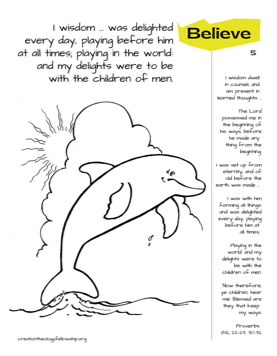
With children, a focus on the fact that God created can open the door to future exploration of the important questions about how God created. Simply raising the topic of creation itself—the fact that God created—can awaken fascination. In Psalm 104, the Psalmist proclaims, “O LORD, how manifold are thy works! In wisdom hast thou made them all”—wow! Fun also has a role to play, not only in the process of learning about creation but in creation itself: In Proverbs 8, Wisdom tells us “The Lord possessed me in the beginning of his ways, before he made any thing from the beginning”; Wisdom describes this as “being delighted every day; playing before him at all times: playing in the world.”
To teach children about creation by way of fascinating! with fun! I created teaching resources that have recently been reissued, all of them free, in updated editions by Creation Theology Fellowship. Creation Theology Fellowship is “a lay fellowship dedicated to the renewal of creation theology within the Catholic Church,” a group “serving the servants of God through creation theology.” And, in adding these materials for children to what Creation Theology Fellowship offers, we are now, as I tell my colleagues in this fellowship, renewing creation theology in the Church “one crayon at a time.”
I created the Marvel, Believe, Care Creation Coloring Book to help teach children about what the Bible has to say about creation. To accompany passages from the Bible about creation, a professional artist kindly donated his talents to create wonderful drawings to color. This coloring book is organized around the themes of Marvel, Believe, Care. A logo represents these with symbolic colors: Marvel is blue—look to the heavens, look to the seas, the lakes, the rivers, and marvel. Believe is yellow—in responding to the awe and wonder of marveling, the light of faith fills us, we believe; and belief, in turn, can enrich the ways we marvel. Care is green, the result of combining blue and yellow—we are humbled in amazement as we marvel; we understand where this all comes from as we believe; and in response, we care as good stewards. The response of care, informed through Catholic Tradition, offers a way to understand our relationship to God’s creation that is an alternative to the political frameworks of environmentalism and climate change activism.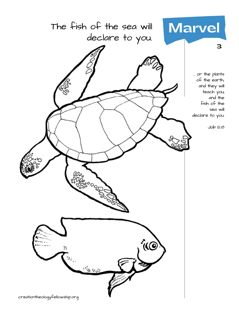
Alongside the coloring book, there are two levels of a Marvel, Believe, Care Creation Activity Book. These offer puzzles, coded messages to decipher, and other fun activities based on passages from the Bible about creation. Like the coloring book, these are organized around the themes of marvel, believe, and care.
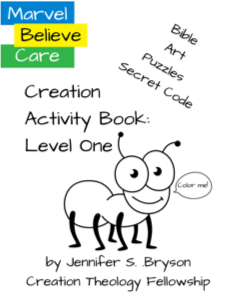 As my personal favorite in this series of resources for children, I developed a puppet show called “The Days of Creation.” This offers a fun way not only to learn about the story of creation but also to share it with others by performing the show. Children make their own puppets to tell the story of the seven days of Creation. A Puppet Show Guide explains how to make the puppets and how to perform the show. The activity of designing and making the puppets offers children a way to participate in creating and makes each performance of the show unique. The script for the show, Genesis 1:1–2:3, is read by a narrator while the puppeteers follow stage cues for when the puppets enter, and then “separate,” “gather,” and “move” on stage in sync with the story, and when they exit as each day of creation is completed. The script with stage cues is available in over half a dozen languages.
As my personal favorite in this series of resources for children, I developed a puppet show called “The Days of Creation.” This offers a fun way not only to learn about the story of creation but also to share it with others by performing the show. Children make their own puppets to tell the story of the seven days of Creation. A Puppet Show Guide explains how to make the puppets and how to perform the show. The activity of designing and making the puppets offers children a way to participate in creating and makes each performance of the show unique. The script for the show, Genesis 1:1–2:3, is read by a narrator while the puppeteers follow stage cues for when the puppets enter, and then “separate,” “gather,” and “move” on stage in sync with the story, and when they exit as each day of creation is completed. The script with stage cues is available in over half a dozen languages.
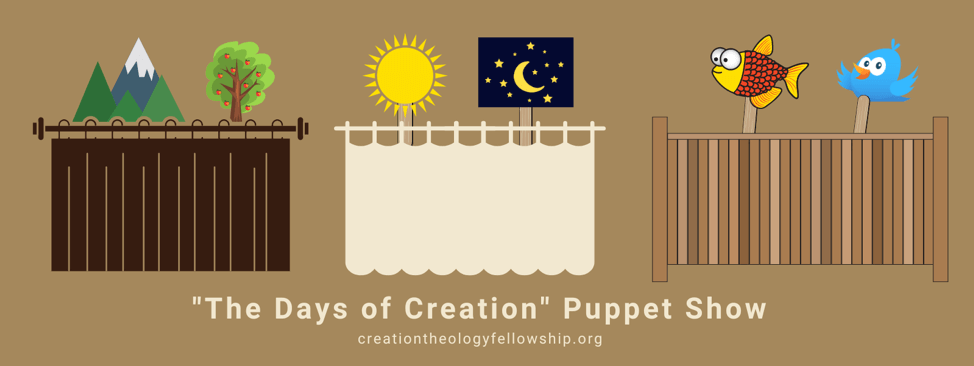
In 2023, Creation Theology Fellowship is running a contest for videos of “The Days of Creation” puppet show. The deadline to enter is November 15, the Feast of Saint Albertus Magnus, who responded to the wonder of God’s creation with study and exploration.
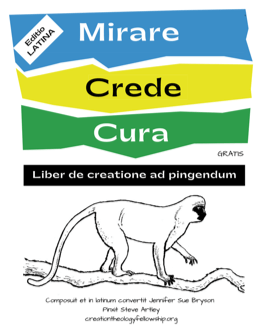 These teaching resources also offer fun ways to introduce children to Latin, a language that is vital for our Catholic Tradition. The Marvel, Believe, Care Creation Coloring Book is available, alongside English, also in Latin. “The Days of Creation” puppet show script is available in Latin and I am currently developing an “In diebus creationis” Latin workbook to help parents and teachers use the puppet show script to teach Latin. In 2024, Creation Theology Fellowship plans to run a video contest for performances of the puppet show in Latin.
These teaching resources also offer fun ways to introduce children to Latin, a language that is vital for our Catholic Tradition. The Marvel, Believe, Care Creation Coloring Book is available, alongside English, also in Latin. “The Days of Creation” puppet show script is available in Latin and I am currently developing an “In diebus creationis” Latin workbook to help parents and teachers use the puppet show script to teach Latin. In 2024, Creation Theology Fellowship plans to run a video contest for performances of the puppet show in Latin.
In tandem with the ongoing debates surrounding the how of creation, we can keep exploring and share the fact of creation. As the Book of Second Maccabees reminds us, “…look upon heaven and earth, and all that is in them: and consider that God made them out of nothing, and mankind also.” Start young, add fascination and fun and let the marvel and awe begin.
Photo by Eutah Mizushima on Unsplash
Jennifer S. Bryson is a Fellow at the Ethics and Public Policy Center (EPPC) in Washington DC and a Visiting Researcher at Hochschule Heiligenkreuz in Austria, where she lives.
"creation" - Google News
July 10, 2023 at 09:37PM
https://ift.tt/lHb6j4I
Teach Children About Creation: Why and How - OnePeterFive
"creation" - Google News
https://ift.tt/VWOgn0Q
https://ift.tt/B0abyX4
Bagikan Berita Ini
















0 Response to "Teach Children About Creation: Why and How - OnePeterFive"
Post a Comment